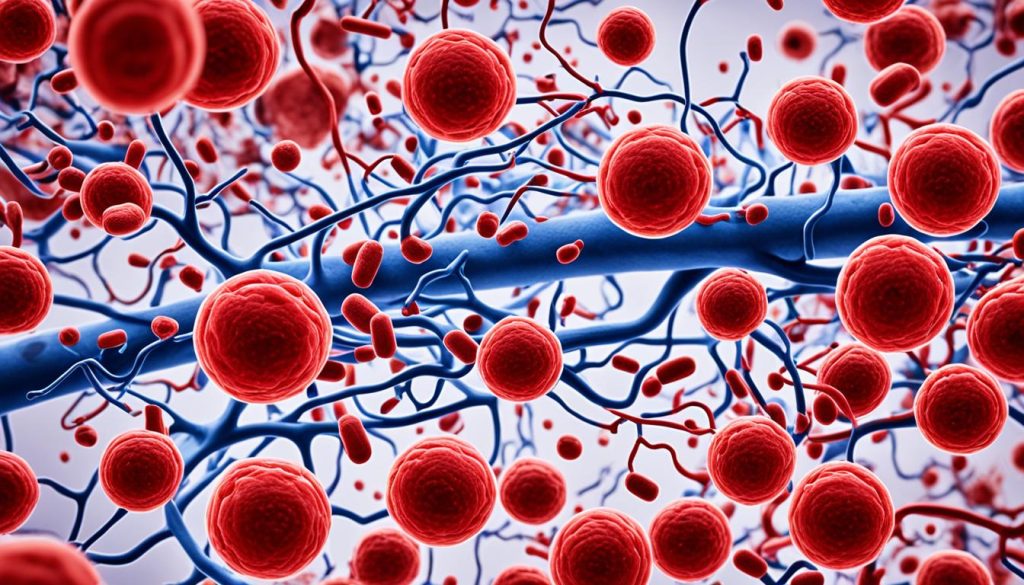A high platelet count, known as thrombocytosis, can have various causes. If you’ve recently received blood test results indicating an elevated platelet count, you may be wondering what could be causing it. Understanding the most common causes can help you gain insights into your condition and make informed decisions about your health.
There are two main categories of high platelet count: essential thrombocytosis and secondary thrombocytosis. Essential thrombocytosis, also called primary thrombocytosis, occurs when the bone marrow produces too many platelets on its own. It is less common than secondary thrombocytosis, but it is essential to understand its implications.
Secondary thrombocytosis, or reactive thrombocytosis, is more prevalent and typically caused by an underlying condition or event. This form of thrombocytosis can be triggered by infections, inflammation, iron deficiency anemia, spleen removal, medication side effects, or certain types of cancer. These factors can disrupt the normal balance of platelet production, leading to an increased platelet count.
If you are curious about the specific causes of secondary thrombocytosis, skip to Section 2 of this article. If you want to learn more about essential thrombocytosis, its causes, and related complications, head to Section 3.
Next, let’s explore the common causes of secondary thrombocytosis in more detail.
Causes of Secondary Thrombocytosis
Secondary thrombocytosis is a common condition that can lead to elevated platelet levels. This condition can be triggered by various factors, including infections, inflammatory conditions, iron deficiency anemia, surgical procedures, certain medications, and certain types of cancer.
- Infections: Infections play a significant role in causing secondary thrombocytosis. Soft tissue, lung, gastrointestinal, urinary, and genital infections are some of the leading causes.
- Inflammatory Conditions: Autoimmune diseases, such as rheumatoid arthritis and inflammatory bowel disease, can contribute to elevated platelet levels.
- Iron Deficiency Anemia: Iron deficiency anemia occurs when the body lacks sufficient iron to produce red blood cells. This condition can also lead to secondary thrombocytosis.
- Splenectomy: In some cases, a spleen removal procedure, known as splenectomy, can result in secondary thrombocytosis.
- Medications: Certain medications, such as myeloid growth factors and corticosteroids, can cause elevated platelet counts as a side effect.
- Certain Types of Cancer: Solid tumor cancers, including breast, colon, ovarian, and lung cancer, are associated with reactive thrombocytosis.
Understanding the underlying causes of secondary thrombocytosis is essential for proper diagnosis and treatment. If you experience symptoms or have concerns about your platelet count, it is important to consult with a healthcare professional.
Secondary Thrombocytosis: Common Causes
| Causes | Description |
|---|---|
| Infections | Soft tissue, lung, gastrointestinal, urinary, and genital infections. |
| Inflammatory Conditions | Autoimmune diseases, rheumatoid arthritis, and inflammatory bowel disease. |
| Iron Deficiency Anemia | Lack of iron leading to insufficient red blood cell production. |
| Splenectomy | Removal of the spleen through surgical procedure. |
| Medications | Certain medications causing elevated platelet counts as a side effect. |
| Certain Types of Cancer | Solid tumor cancers, including breast, colon, ovarian, and lung cancer. |
Causes of Essential Thrombocytosis
Essential thrombocytosis, also known as primary thrombocytosis, is a less common cause of high platelet count. It is a blood and bone marrow disease characterized by the overproduction of platelets. The exact cause of essential thrombocytosis is unclear, but it is believed to be influenced by genetic factors. Around half of people with essential thrombocytosis have a mutation in the JAK2 gene. This condition is rare and typically affects older adults, especially females. It is rarely seen in children. Essential thrombocytosis can lead to complications such as blood clots, strokes, heart attacks, and, in rare cases, progression to acute myeloid leukemia.
To better understand the causes of essential thrombocytosis, here is a summarized table:
| Potential Causes of Essential Thrombocytosis |
|---|
| Genetic factors |
| Approximately 50% of individuals with essential thrombocytosis have a mutation in the JAK2 gene. |
| Gender and age |
| Essential thrombocytosis is more prevalent among older adults, particularly females. |
| Complications |
| Essential thrombocytosis can lead to blood clots, strokes, heart attacks, and, in rare instances, progression to acute myeloid leukemia. |
Understanding the causes of essential thrombocytosis is crucial in pinpointing the underlying factors contributing to high platelet counts. This knowledge allows healthcare professionals to develop effective treatment strategies and manage potential complications associated with this condition.
Now that we have explored the causes of both secondary and essential thrombocytosis, let’s delve into the symptoms of high platelet count in the next section.
What is the Most Common Cause of High Platelet Count?
In many cases, individuals with high platelet counts do not experience any symptoms. However, when symptoms do arise, they are often related to blood clotting. Some common symptoms of high platelet counts include:
- Headaches: Some individuals may experience frequent headaches, which can range from mild to severe.
- Confusion or changes in speech: High platelet counts can affect cognitive function, resulting in confusion or changes in speech.
- Chest pain: Some individuals may experience chest pain or discomfort, which may be a sign of a blood clot in the arteries of the heart.
- Shortness of breath and nausea: Elevated platelet levels can lead to difficulty breathing and feelings of nausea or vomiting.
- Weakness: Fatigue and weakness are common symptoms associated with high platelet counts.
- Burning pain in the hands or feet: Some individuals may experience a burning sensation or tingling in the hands or feet, which may be a sign of poor blood circulation.
In rare instances, very high platelet levels may cause bleeding, resulting in nosebleeds, bruising, bleeding from the mouth or gums, or bloody stool.
Related Image:

Complications of High Platelet Count
While a high platelet count itself may not always be harmful, it can increase the risk of certain complications. Essential thrombocytosis, in particular, can lead to potentially life-threatening complications. It may result in the formation of blood clots, increasing the risk of strokes and heart attacks.
In rare cases, essential thrombocytosis can progress to acute myeloid leukemia, a type of aggressive blood cancer. Pregnancy complications, such as miscarriage, can also occur in individuals with uncontrolled thrombocytosis. Additionally, some individuals with primary thrombocytosis may develop scar tissue in the bone marrow or progress to a preleukemia condition called myelodysplastic syndrome.
| Complications of High Platelet Count | Description |
|---|---|
| Blood Clots | Increased risk of strokes and heart attacks |
| Acute Myeloid Leukemia | Rare progression to aggressive blood cancer |
| Pregnancy Complications | Higher risk of miscarriage |
| Scarring in Bone Marrow | Development of scar tissue in the bone marrow |
| Myelodysplastic Syndrome | Progression to preleukemia condition |

In some cases, addressing the underlying cause of the high platelet count can help manage and reduce the risk of complications. Individuals with elevated platelet levels should consult with a healthcare professional to determine the appropriate course of action and potential treatment options.
Conclusion
A high platelet count can have various causes, with secondary thrombocytosis being the most common. Infections, inflammation, iron deficiency anemia, spleen removal, medication side effects, and certain types of cancer can all trigger secondary thrombocytosis. On the other hand, essential thrombocytosis, a less common cause, is a blood and bone marrow disease influenced by genetic factors.
Having a high platelet count itself may not always cause symptoms. However, it is important for individuals with elevated levels to consult with a healthcare professional for proper evaluation and diagnosis. Identifying the underlying cause of the high platelet count is essential in determining the appropriate treatment plan.
If left untreated, complications can arise from high platelet levels. Blood clots, strokes, heart attacks, and, in rare cases, progression to acute myeloid leukemia can occur in individuals with essential thrombocytosis. Therefore, early detection and intervention are crucial to prevent potential health risks.






